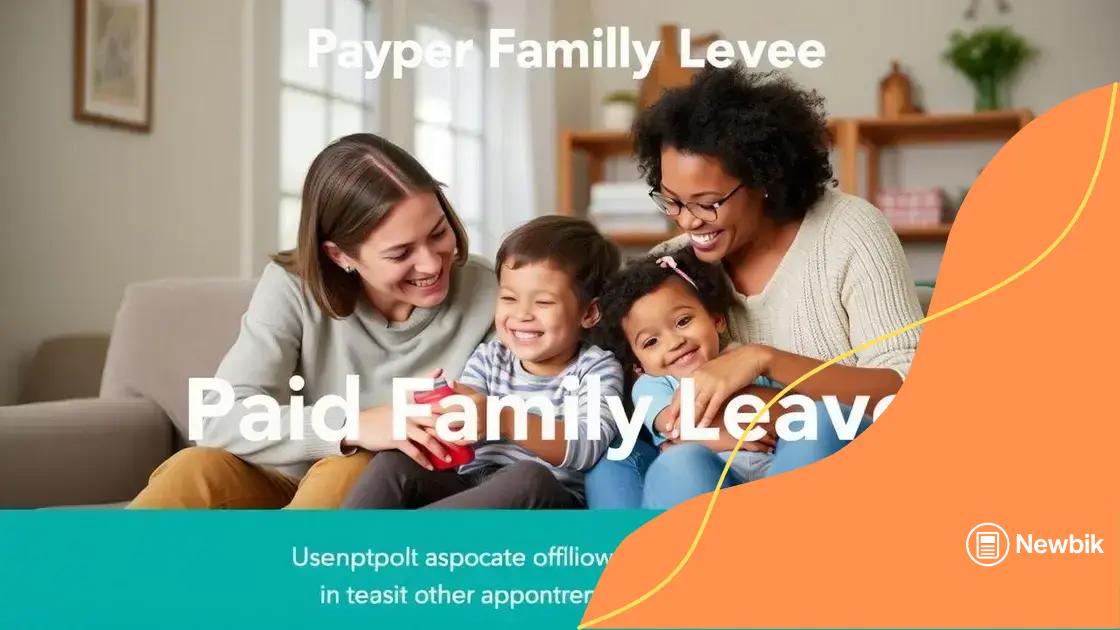Paid family leave policies US: what you need to know

Paid family leave policies in the US provide essential support for families, allowing employees to take paid time off for caregiving during significant life events, ensuring better work-life balance and healthier family dynamics.
Paid family leave policies US are gaining attention as they shape the way families manage work and caregiving. Have you ever wondered how these policies can directly affect your life and the lives of those around you?
Understanding paid family leave policies in the US
Understanding paid family leave policies in the US is essential for families navigating the complexities of work and caregiving. These policies offer essential support, allowing caregivers to balance their responsibilities without jeopardizing their financial stability.
In the United States, the landscape of paid family leave can be complicated. Many employees are unaware of their rights or the specific policies in their states. This can lead to confusion and missed opportunities for support. It’s important to explore how these policies operate and who they impact.
Types of Paid Family Leave
There are various types of paid family leave policies in the US that can cater to different needs:
- Parental leave: This is typically for new parents bonding with their child, including both maternity and paternity leave.
- Medical leave: Employees may take time off to care for their own health needs or a family member’s medical conditions.
- Caregiving leave: This type allows employees to take time off to care for family members with serious health issues.
Understanding these categories helps employees identify which type of leave applies to their situation. Clarity can empower employees to utilize their rights effectively.
The Impact on Families
Paid family leave policies can significantly affect the well-being of families. For example, parents who take leave can provide better care during crucial developmental stages of their children’s lives. This time together fosters stronger family bonds and encourages healthy development.
Moreover, having access to paid leave can reduce stress for parents as they navigate new responsibilities. It allows them to focus on their family without the added pressure of financial constraints.
Many people wonder about the long-term effects of these policies on workplace dynamics. Research shows that organizations supporting paid family leave often experience higher employee satisfaction and retention rates. Happy employees are less likely to leave, creating a more stable workplace environment.
As the conversation about paid family leave continues to evolve, it is crucial to advocate for comprehensive policies that serve each family’s unique needs. This understanding can lead to informed discussions at workplaces and communities.
Different types of paid family leave
When discussing different types of paid family leave, it’s important to understand the variety of policies that exist to support families during critical times. These types can significantly affect how individuals manage their work-life balance while caring for loved ones.
Parental Leave
Parental leave is designed for parents welcoming a new child, either through birth or adoption. This leave can be essential for bonding with the baby and adjusting to new family dynamics. Typically, parental leave offers both maternity and paternity options, ensuring that both parents can take needed time off.
Medical Leave
This type of leave is for employees who require time to address their own health issues or those of an immediate family member. Medical leave allows individuals to receive necessary care without the stress of losing income. Employees can focus on recovery and wellness, knowing their jobs are secure.
Caregiving Leave
Caregiving leave is crucial for those who need to take care of family members with serious health concerns. This leave can provide motivation for employees to take time off when their loved ones need them the most. During such stressful periods, compensation through caregiving leave can support families both emotionally and financially.
These related types of paid family leave help ensure that individuals are not forced to choose between their jobs and their family responsibilities. Understanding these options enables employees to make informed decisions about their time off and family needs.
Additional policies may include flexible leave, which allows employees to customize their leave based on personal circumstances. This flexibility can have a positive impact on both employee morale and company culture.
Paid family leave is not just about time off; it’s about supporting healthy family dynamics. The various types of leave serve as a foundation for a balanced and sustainable working environment.
Impact of paid family leave on parents and children

The impact of paid family leave on parents and children is profound and far-reaching. When parents can take time off work, it creates a supportive environment for both their children and themselves. This time allows families to bond, adjust to new routines, and focus on emotional well-being.
Research has shown that parents who take paid family leave report higher levels of satisfaction in their roles. This, in turn, leads to a more positive family atmosphere. For instance, children benefit from having attentive caregivers at home, which can foster better developmental outcomes.
Emotional Benefits
Having the opportunity for paid family leave can significantly reduce parental stress. Parents who feel supported at work and at home are more likely to engage positively with their children. A calmer environment promotes healthy relationships and improves communication within the family. Children feel more secure when their parents are present and attentive.
Developmental Outcomes
The time allowed for bonding during paid family leave can positively affect children’s development. Early interactions are crucial for brain development, especially in infants and toddlers. When parents can provide consistent care and engagement during this period, it sets the foundation for learning and emotional health.
- Increased attachment: Children develop stronger emotional bonds with their parents.
- Better health: Children tend to experience fewer health issues when cared for at home.
- Improved development: More time with parents can lead to healthier cognitive and social development.
In essence, paid family leave serves not just as time off work, but as a critical investment in the future of children. The ability for parents to be available during significant life changes results in healthier family dynamics and improved well-being.
As society progresses, understanding these impacts helps shape conversations about the importance of comprehensive family leave policies. When we advocate for better leave options, we also advocate for healthier families and stronger communities.
Challenges and gaps in paid family leave policies
The challenges and gaps in paid family leave policies are significant obstacles that many families face. Despite the benefits associated with such policies, there are still major issues that prevent them from being effective for all workers.
One of the primary challenges is the lack of uniformity across different states. While some states have established comprehensive paid family leave programs, others offer little to no support. This inconsistency can leave families uncertain about their rights and options. It can also create disparities between workers in different regions.
Access and Eligibility
Another issue is access to these benefits. Many paid family leave policies have strict eligibility requirements. For example, employees may need to work a specific number of hours or be employed for a certain duration before qualifying. This can lead to situations where hardworking individuals are excluded from benefiting.
Duration and Compensation
The duration and level of compensation also pose challenges. In some cases, the time allowed for leave is insufficient to support families adequately. Similarly, the pay provided during leave may not be enough to cover living expenses, forcing families to choose between caring for loved ones and financial stability.
- Financial Constraints: Employers may hesitate to offer generous paid leave due to concerns about financial costs.
- Awareness: Many employees are unaware of their rights, leading them to miss out on available benefits.
- Workplace Culture: Company cultures that do not support taking leave can discourage employees from utilizing these policies.
These challenges highlight the need for reform and advocacy to create more inclusive paid family leave policies. Efforts to standardize and expand these programs can help to ensure that all families receive the support they need during critical times in their lives.
Future of paid family leave in the United States
The future of paid family leave in the United States is evolving as societal attitudes toward work-life balance shift. There is growing recognition of the importance of supporting families during significant life events.
Currently, discussions around paid family leave continue to gain momentum, fueled by advocacy from various groups. Many people believe that expanding paid leave policies can lead to healthier families and stronger communities. As more states and organizations implement these policies, the hope is that comprehensive, standardized paid family leave will become a national norm.
Potential Reforms
Future reforms may involve creating a federal paid family leave program that guarantees benefits for all workers, regardless of their state of employment. Such a program could provide more equitable access to leave, making it easier for families to take the time they need without fear of losing income.
Employer Involvement
Employers are also key players in shaping the future of paid family leave. Many companies are recognizing the benefits of offering generous leave policies. They understand that investing in employee well-being can lead to increased productivity and job satisfaction. Moreover, a positive workplace culture encourages employees to utilize these benefits without fear of stigma.
- Enhanced policies: Companies may begin to offer more flexible leave options that cater to individual employee needs.
- Support for diverse families: There’s an increasing focus on making paid leave policies inclusive for all family structures.
- Public awareness: Enhanced awareness campaigns can educate employees about their rights and options regarding paid family leave.
As conversations about work-life balance continue, the expectations of both employees and employers will likely drive changes in paid family leave policies. Advocating for comprehensive leave options will remain essential, as they play a crucial role in ensuring families and businesses thrive.
In conclusion, the future of paid family leave in the United States hinges on continued advocacy, awareness, and reform. As society evolves, recognizing the importance of supporting families during critical times is paramount. Expanding access and improving policies will benefit not just individuals, but entire communities. Employers also play a key role in this transformation, with many now understanding that investing in their employees’ well-being is crucial. Together, we can shape a future where paid family leave is a standard for all, ensuring that families have the time they need to thrive.
FAQ – Frequently Asked Questions about Paid Family Leave Policies
What are paid family leave policies?
Paid family leave policies provide employees with paid time off to care for family members or themselves during significant life events, such as the birth of a child or serious health issues.
Who is eligible for paid family leave in the United States?
Eligibility for paid family leave varies by state. Generally, employees need to meet certain work-hour thresholds and be employed for a minimum time before qualifying.
What are the benefits of paid family leave for families?
Paid family leave allows families to bond during important life moments, reduces stress, and supports child development, ensuring parents can care for their loved ones without financial strain.
How can companies benefit from offering paid family leave?
Companies that offer paid family leave often see improved employee morale, reduced turnover, and better workplace culture, as employees feel supported and valued.